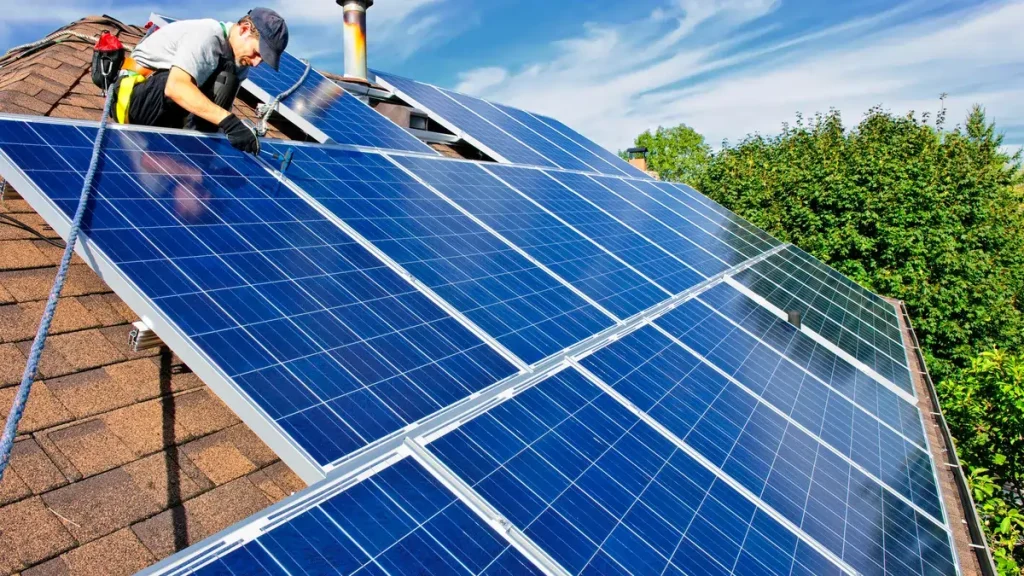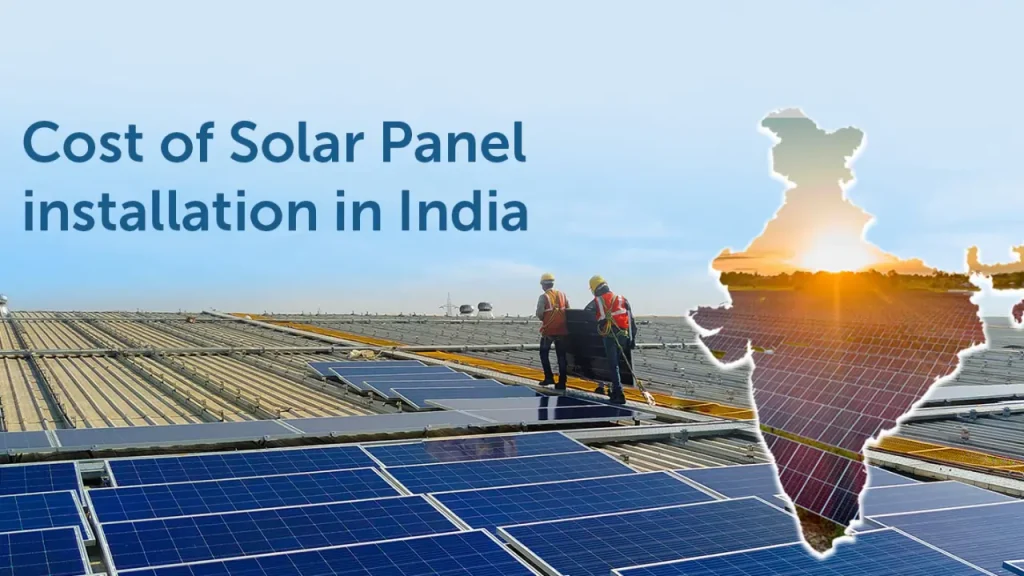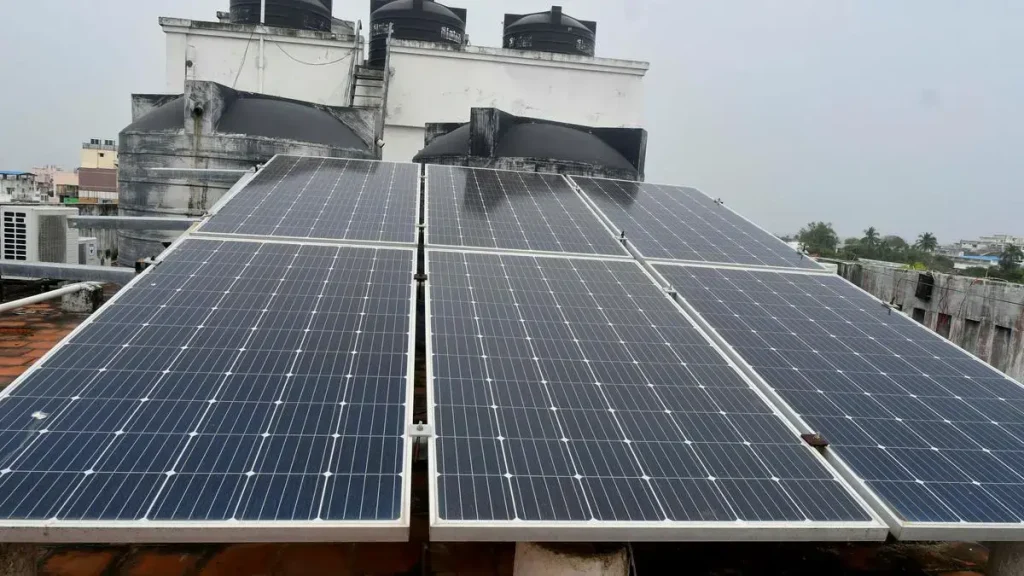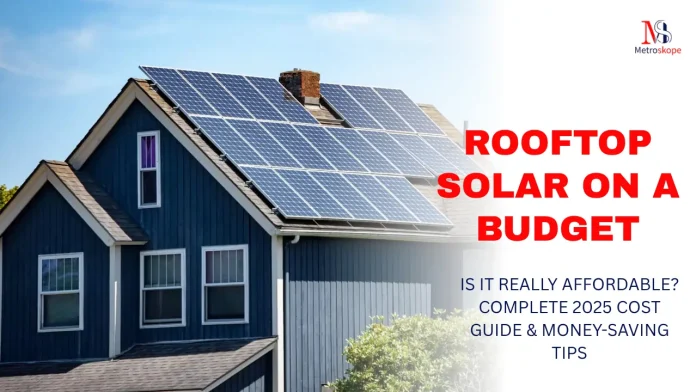Rooftop Solar on a Budget: You’re scrolling through your electricity bill, and suddenly you feel like you’ve been punched in the wallet by a very expensive, very unsympathetic monopoly.
The numbers keep climbing month after month, and you start wondering if your air conditioner has developed a gambling addiction.
Then, like a ray of sunshine (pun absolutely intended), you see an ad for rooftop solar promising “free electricity forever!”
But wait – is rooftop solar actually affordable, or is it just another expensive dream dressed up in shiny marketing? The short answer: It depends on your definition of “budget” and how long you’re willing to wait for those savings to kick in.
The long answer? Well, grab your calculator and maybe a cup of coffee, because we’re about to dive deep into the wonderfully complex world of rooftop solar economics.
The Great Solar Sticker Shock: What You’re Actually Looking At
The Reality Check Numbers
Let’s start with the elephant in the room – the upfront costs that make your credit card weep.

According to current market data, here’s what you’re looking at for a typical residential rooftop solar installation in India:
| System Size | Cost Range (Before Subsidy) | After Government Subsidy | Monthly Savings Potential |
|---|---|---|---|
| 1kW | ₹75,000 – ₹85,000 | ₹45,000 – ₹55,000 | ₹800 – ₹1,200 |
| 3kW | ₹1,89,000 – ₹2,15,000 | ₹1,11,000 – ₹1,37,000 | ₹2,400 – ₹3,600 |
| 5kW | ₹3,15,000 – ₹3,57,000 | ₹2,37,000 – ₹2,79,000 | ₹4,000 – ₹6,000 |
| 10kW | ₹5,31,000 – ₹6,07,000 | ₹4,53,000 – ₹5,29,000 | ₹8,000 – ₹12,000 |
The good news: These aren’t the final prices you’ll pay. The potentially scary news: Even after subsidies, we’re still talking about the cost of a decent car for larger systems.
Breaking Down Where Your Money Actually Goes
When you’re wondering why solar costs what it costs, here’s the honest breakdown that no salesperson wants to explain in detail:
- Solar Panels: 40-50% of total cost (the actual electricity-generating heroes)
- Inverter: 15-20% (the translator that turns DC to AC power)
- Mounting Structure: 10-15% (keeps everything attached to your roof)
- Installation & Labor: 15-20% (someone has to climb up there)
- Permits & Paperwork: 5-10% (bureaucracy never sleeps)
“The cost of generating electricity can be easily calculated with solar rooftops. Unlike traditional electricity prices that fluctuate, the price of power generated by solar rooftops remains consistent.”
The Government’s Gift: Subsidies That Actually Make a Difference
PM Surya Ghar: When Politicians Actually Help Your Wallet
Here’s where things get interesting (and significantly more affordable). The PM Surya Ghar: Muft Bijli Yojana isn’t just a fancy name – it’s a genuine game-changer for budget-conscious solar adopters.
The subsidy breakdown that’ll make you smile:
- ₹30,000 per kW for the first 2kW
- ₹18,000 per kW for additional capacity up to 3kW
- Maximum subsidy of ₹78,000 for systems 3kW and above
The Catch (Because There’s Always a Catch)
Before you start planning your subsidy spending spree, here are the fine print details:
- Only for residential consumers (sorry, business owners)
- Must use MNRE-empanelled vendors (no random guy with a van)
- Grid-connected systems only (has to play nice with the electricity grid)
- Valid electricity connection required (you need to be a legitimate power consumer)
Real-world example: Ramesh from Jaipur learned this the hard way when he installed a 5kW system with a non-approved vendor and couldn’t claim his ₹78,000 subsidy.
Moral of the story: Always check the approved vendor list before signing anything.
The State vs State Solar Olympics: Where You Live Matters

The Solar-Friendly States Hall of Fame
Not all states are created equal when it comes to solar affordability. Some states are like that generous friend who always picks up the dinner tab, while others are more like that friend who “forgot” their wallet again.
The Solar Superstars (states that actually want you to go solar):
- Delhi: Additional subsidies bringing total support to 40%+ of costs
- Gujarat: Pays ₹2.25 per unit for surplus power for 5 years
- Uttarakhand: Offers ₹5 per unit for excess power (the golden goose!)
- Goa: Free solar systems for households using less than 400 units monthly
The Solar Strugglers: Some states offer minimal additional support beyond central government schemes, meaning your mileage may vary significantly based on your zip code.
The DIY Route: When You’re Feeling Adventurous (and Broke)
Budget Solar for the Brave
If the traditional installation costs are making your wallet cry, there’s always the DIY approach. You can start a basic solar setup for as little as $500 (around ₹40,000), but there are some important caveats.
Your DIY Shopping List:
- Solar Panels: 30W setup with 3 panels (~₹15,000-20,000)
- Battery: Deep cycle AGM or lithium (~₹8,000-15,000)
- Charge Controller: Prevents overcharging (~₹2,500-4,000)
- Inverter: Converts DC to AC power (~₹4,000-8,000)
The DIY Reality Check
What you can realistically power with a budget DIY system:
- LED lights throughout your home
- Phone and laptop charging stations
- Small fans
- TV and entertainment system
- What you probably can’t power: Air conditioning, water heaters, or your entire household load
“Lisa in California set up a 201W system for $450 to run her outdoor lights and tools. No electrician needed for portable systems.”
The Payback Period: When Your Solar Investment Starts Making Sense
The Math That Matters
Here’s the question everyone wants answered: “When will this thing actually start saving me money?” The answer depends on several factors that solar salespeople often gloss over.
Typical payback periods in India:
- High solar states (Gujarat, Rajasthan): 4-6 years
- Moderate solar states (Delhi, Maharashtra): 6-8 years
- Lower solar potential areas: 8-12 years
Real-World Payback Example
Let’s say you install a 5kW system in Delhi:
- Total cost: ₹3,50,000
- Government subsidy: ₹78,000
- Additional Delhi subsidy: ₹70,000 (assuming 20% additional)
- Your actual investment: ₹2,02,000
- Monthly electricity savings: ₹5,000
- Annual savings: ₹60,000
- Payback period: 3.4 years
After payback, you’re looking at 20+ years of essentially free electricity (minus minimal maintenance costs).
The Hidden Costs Nobody Talks About
The “Oh, We Didn’t Mention That” Expenses
While solar salespeople love talking about savings, they’re often mysteriously quiet about these additional costs:
| Hidden Cost | Typical Amount | Why It Matters |
|---|---|---|
| Annual Maintenance | ₹5,000-15,000 | Cleaning, inspection, minor repairs |
| Inverter Replacement | ₹50,000-1,00,000 | Usually needed after 8-12 years |
| Insurance | ₹5,000-10,000/year | Protection against damage/theft |
| Monitoring System | ₹10,000-25,000 | Track performance and issues |
The Maintenance Reality
Solar panels are relatively low-maintenance, but they’re not no-maintenance. In dusty Indian conditions, regular cleaning is essential.
Professional cleaning might cost ₹2,000-5,000 annually, or you can embrace your inner weekend warrior and do it yourself.
Smart Strategies to Make Solar Actually Affordable

The Budget-Conscious Buyer’s Playbook
1. Size Your System Correctly
Don’t let salespeople talk you into a system that’s bigger than you need. Start with your actual electricity consumption, not your theoretical maximum usage.
2. Time Your Purchase Like a Pro
- Monsoon season: Installers offer discounts to maintain cash flow
- End of financial year: Companies want to meet targets
- Festival seasons: Special promotional offers
3. Compare Financing Options
| Financing Method | Pros | Cons |
|---|---|---|
| Cash Purchase | Lowest total cost, full subsidies | High upfront investment |
| Solar Loans | Spread costs over time | Interest adds to total cost |
| Lease/PPA | No upfront cost | Lower long-term savings |
4. Don’t Ignore Quality for Price
Cheap solar panels are like cheap parachutes – the savings might not be worth the risk. Look for panels with at least 18-20% efficiency and 25-year warranties7.
“When going solar, quality solar equipment and installations may not come for cheap offers. Look for high-quality materials.”
The Environmental Math: When Feeling Good Costs Less
The Carbon Savings That Actually Matter
Here’s something that makes the investment feel better: A typical 5kW rooftop solar system prevents about 6-8 tons of CO2 emissions annually. Over 25 years, that’s equivalent to planting about 2,500 trees.
The environmental payback happens much faster than the financial payback – usually within 1-2 years, your system has generated enough clean energy to offset the energy used in manufacturing it.
The Verdict: Is Budget Solar Actually Possible?
The Honest Answer
Yes, rooftop solar can be affordable, but it requires:
- Realistic expectations about upfront costs and payback periods
- Smart system sizing based on actual needs, not aspirational usage
- Taking advantage of every available subsidy and incentive
- A long-term perspective (think 10+ years, not 2-3 years)
The Sweet Spot Strategy
For most budget-conscious homeowners, the sweet spot is a 3-5kW system that:
- Covers 60-80% of your electricity needs
- Qualifies for maximum government subsidies
- Has a reasonable payback period of 5-7 years
- Doesn’t require rewiring your entire electrical system
After subsidies, a well-planned rooftop solar system typically costs about the same as 3-4 years of your current electricity bills. After that initial period, you’re essentially getting free electricity for the next 20+ years.
The final consideration: In a country where electricity tariffs increase 5-8% annually, locking in your electricity costs at today’s rates through solar isn’t just about being budget-conscious – it’s about being future-smart.
So, is rooftop solar really affordable? If you can handle the upfront investment and take a long-term view, absolutely.
If you’re looking for immediate savings with no initial outlay, you might want to stick with energy-efficient appliances and prayer to the electricity gods.

